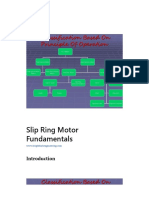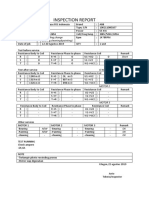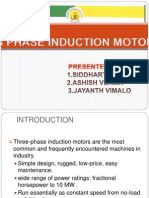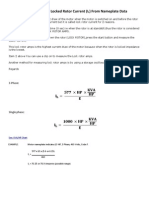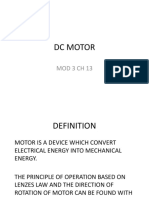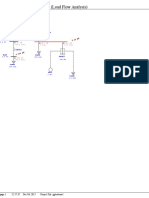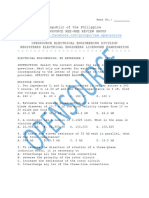How To Calculate Motor Inrush Current 2
Uploaded by
Gary GohHow To Calculate Motor Inrush Current 2
Uploaded by
Gary GohConsult the NEMA Locked Rotor Code Table and find the letter code on
it. Follow the letter code row to the right and find the range given. The
range is given in thousands of Volt-Amps, or kilowatts.
o 4 Multiply each number in the range by 1,000. Divide each result by the
motor voltage found on the nameplate. The resulting range is the inrush
current range. For example: A 3.5-horsepower, three-phase motor
nameplate lists the motor voltage as 230 volts and the locked rotor code
is "K." The range given on the table is 8.0 to 8.99 KVA. Multiplying by
1,000, the range becomes 8,000 to 8,990 VA. Dividing by the motor
voltage of 230 volts gives the inrush current range as 34.8 amps to 39.1
amps.
Tips & Warnings
The inrush current is only momentary and if the circuit breaker is sized
properly, it will not trip in the fraction of second the current spikes. As the
motor windings become energized, they present resistance to the flow of
current and the current begins to drop. As the motor comes up to full
speed, the current level will be at the level specified on the motor
nameplate as the full-load current.
The voltage is important to determining inrush current. If the motor
nameplate lists multiple voltages, the voltage being used must be
determined. An easy place to measure this is at the motor disconnect. The
type of voltage determines how the measurement is made. Measure three-
phase current between two hot terminals and double it. Split phase current
is measured between two hot terminals. Single phase current is measured
from the hot terminal to ground.
Resources
Engineering Toolbox: Electrical Motor Locked Rotor Indicating Code Letters
You might also like
- Theory of Operation - Autotransformer Starter PDF100% (1)Theory of Operation - Autotransformer Starter PDF3 pages
- Form - Wound - Repair - Specification Rewinding PDFNo ratings yetForm - Wound - Repair - Specification Rewinding PDF10 pages
- What Is An Electric Motor?: - Electromechanical Device That Converts - Mechanical Energy Used To E.GNo ratings yetWhat Is An Electric Motor?: - Electromechanical Device That Converts - Mechanical Energy Used To E.G37 pages
- BRUTSCH - ... - Conductor Insulation For Rotating Machines - ARTICLENo ratings yetBRUTSCH - ... - Conductor Insulation For Rotating Machines - ARTICLE5 pages
- Types of Electrical Protection Relays or Protective Relays - Electrical Engineering PDFNo ratings yetTypes of Electrical Protection Relays or Protective Relays - Electrical Engineering PDF6 pages
- Code of Practice For Storage, Installation and Maintenance of Induction MotorsNo ratings yetCode of Practice For Storage, Installation and Maintenance of Induction Motors48 pages
- High-Voltage-Test - IS 40291967-Guide For Testing Three Phase Induction MotorNo ratings yetHigh-Voltage-Test - IS 40291967-Guide For Testing Three Phase Induction Motor1 page
- Electrical Machines 1 Lab Manual May 2015No ratings yetElectrical Machines 1 Lab Manual May 2015129 pages
- Electric Motors: - Classification / TypesNo ratings yetElectric Motors: - Classification / Types24 pages
- Rotary Encoder - Wikipedia, The Free EncyclopediaNo ratings yetRotary Encoder - Wikipedia, The Free Encyclopedia7 pages
- General Purpose Slip-Ring Induction Motors: Product Catalogue100% (2)General Purpose Slip-Ring Induction Motors: Product Catalogue12 pages
- 3phim T Slipcharacteristics Problems 181124171548No ratings yet3phim T Slipcharacteristics Problems 18112417154822 pages
- SM101 Life Expectancy Analysis Program (LEAP) Rev ANo ratings yetSM101 Life Expectancy Analysis Program (LEAP) Rev A2 pages
- Reduced Voltage Starting Using Part Winding Technique of 3-Phase Cage Rotor Induction MotorNo ratings yetReduced Voltage Starting Using Part Winding Technique of 3-Phase Cage Rotor Induction Motor8 pages
- E1 Alternator - Open Circuit CharacteristicNo ratings yetE1 Alternator - Open Circuit Characteristic7 pages
- How To Calculate Locked Rotor Current (IL) From Nameplate Data93% (15)How To Calculate Locked Rotor Current (IL) From Nameplate Data4 pages
- Boat Maintenance Companions: Electrics & Diesel Companions at SeaFrom EverandBoat Maintenance Companions: Electrics & Diesel Companions at SeaNo ratings yet
- One-Line Diagram - Olv1 (Short-Circuit Analysis) : U1 228.631 Mvasc 228.631 Mvasc U1No ratings yetOne-Line Diagram - Olv1 (Short-Circuit Analysis) : U1 228.631 Mvasc 228.631 Mvasc U11 page
- One-Line Diagram - OLV1 (Star Sequence-of-Operation) : 0 KV 0 25.036 Ka - 84. 29 0 KV 0 25.036 Ka - 84. 29No ratings yetOne-Line Diagram - OLV1 (Star Sequence-of-Operation) : 0 KV 0 25.036 Ka - 84. 29 0 KV 0 25.036 Ka - 84. 291 page
- One-Line Diagram - OLV1 (Load Flow Analysis) : 0.4 KV 0.4 KVNo ratings yetOne-Line Diagram - OLV1 (Load Flow Analysis) : 0.4 KV 0.4 KV1 page
- One-Line Diagram - OLV1 (Load Flow Analysis) : 496.3 KW 11.8 KvarNo ratings yetOne-Line Diagram - OLV1 (Load Flow Analysis) : 496.3 KW 11.8 Kvar1 page
- Power Transformer Winding Arrangements: Electrical Circuit Breakers, Fuses, ProteNo ratings yetPower Transformer Winding Arrangements: Electrical Circuit Breakers, Fuses, Prote1 page
- Switchgear Operation and Maintenance Fo : LibraryNo ratings yetSwitchgear Operation and Maintenance Fo : Library1 page
- Manual de Servicio Centrifuga EppendorfNo ratings yetManual de Servicio Centrifuga Eppendorf36 pages
- Generator Technical Excitation System SpecificationNo ratings yetGenerator Technical Excitation System Specification20 pages
- Wireless Control of A Three Phase Induction Motor With Short Circuit, Overload and Phase Failure ProtectionNo ratings yetWireless Control of A Three Phase Induction Motor With Short Circuit, Overload and Phase Failure Protection51 pages
- (Ebook Science - PDF) Nikola Tesla Electric Car Part-1No ratings yet(Ebook Science - PDF) Nikola Tesla Electric Car Part-115 pages
- Bomag Mph100 Soil Stabilizer Asphalt Recycler Spare Parts Catalog Manual DownloadNo ratings yetBomag Mph100 Soil Stabilizer Asphalt Recycler Spare Parts Catalog Manual Download248 pages
- Eet June Paper Two Finals With Answers.No ratings yetEet June Paper Two Finals With Answers.17 pages
- Parallel Operation of Three-Phase AlternatorsNo ratings yetParallel Operation of Three-Phase Alternators13 pages
- Generator Inspection Report Original - AlstomNo ratings yetGenerator Inspection Report Original - Alstom19 pages
- Speed Control of 3 Phase Slip Ring Induction MotorNo ratings yetSpeed Control of 3 Phase Slip Ring Induction Motor2 pages
- Anatomy of A Short Circuit - Open ElectricalNo ratings yetAnatomy of A Short Circuit - Open Electrical5 pages
- Starting Instruction of PMM With Triol AK06 VSD With UMKA03 ControllerNo ratings yetStarting Instruction of PMM With Triol AK06 VSD With UMKA03 Controller27 pages
- S6L1D-E4 Wdg.311/312 - Technical Data SheetNo ratings yetS6L1D-E4 Wdg.311/312 - Technical Data Sheet9 pages
- Derive The Output Equation of Single Phase Transformer Heat Dissipation in Electrical Machines, Such As Motors andNo ratings yetDerive The Output Equation of Single Phase Transformer Heat Dissipation in Electrical Machines, Such As Motors and3 pages













